Your Guide to a Daily Sugar Intake Calculator
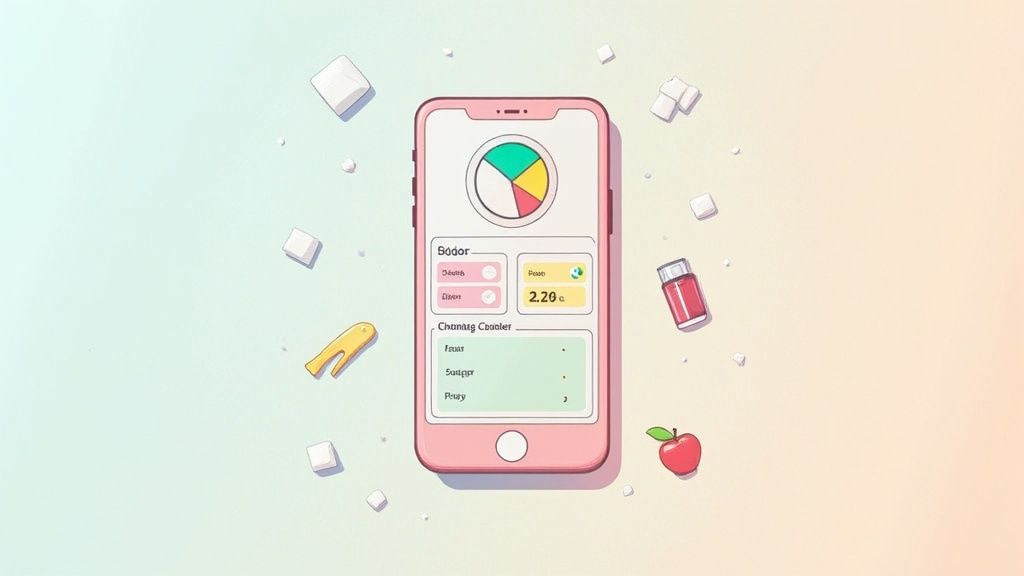
A daily sugar intake calculator is a straightforward tool, but its real power lies in showing you how much sugar you actually consume each day. It cuts through the confusion of nutrition labels and stacks your daily total up against what health experts recommend. This simple comparison can be a game-changer for your health and weight management efforts.
Why Tracking Your Sugar Intake Is a Bigger Deal Than You Think
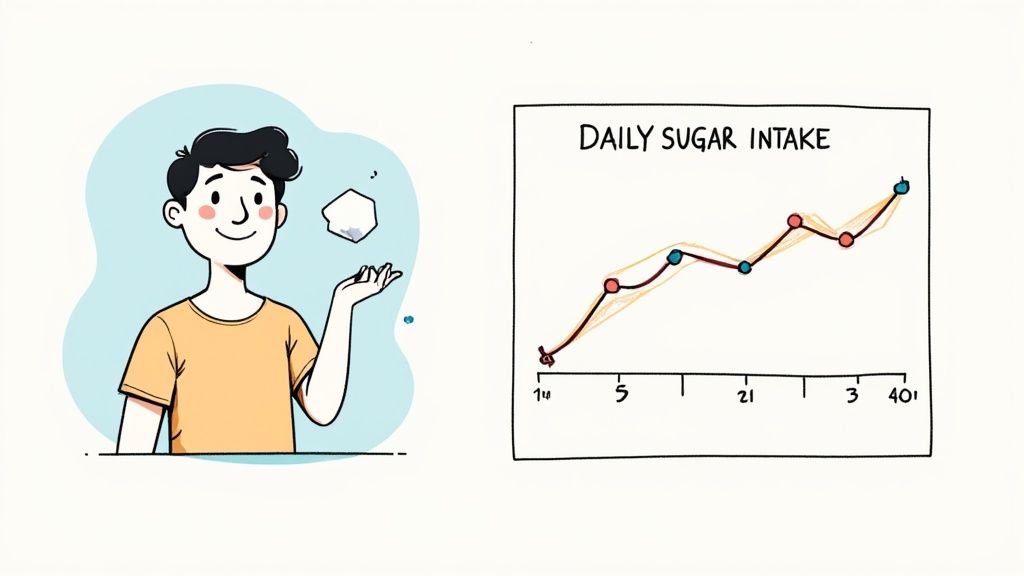
Sound familiar? You're eating salads, grabbing snacks labeled "healthy," and passing on dessert, but you still feel drained and the scale won’t budge. The likely culprit is hidden sugar. It's tucked away in some of the most surprising places—pasta sauce, your morning yogurt, and even that "healthy" whole-wheat bread.
This is exactly why getting a handle on your intake is so important. The sugar you get from an apple is packaged with fiber and nutrients, a world away from the added sugars pumped into a bottle of ketchup. Your body handles them in completely different ways, and it’s those added sugars that can cause serious health problems when you have too much.
The Staggering Reality of Sugar Consumption
Most of us have no idea just how much sugar we're eating. In the United States, the average person consumes an eye-watering 126.4 grams of sugar every single day.
To put that number in perspective, let's look at what major health organizations actually recommend.
Recommended Daily Sugar Limits vs. Average Consumption
| Guideline Source | Recommended Limit (grams/day) | Average US Intake (grams/day) |
|---|---|---|
| American Heart Association (AHA) | 25g (women), 36g (men) | 126.4g |
| World Health Organization (WHO) | 25g (ideal), 50g (max) | 126.4g |
The difference is stark. Consistently eating that much over the recommended limit is directly linked to a host of serious health issues, including:
- A higher risk of developing type 2 diabetes
- Persistent weight gain and obesity
- Chronic inflammation and that feeling of always being tired
- An increased chance of heart disease
Tracking your sugar turns vague health warnings into a tangible, personal number. This isn't about harsh restrictions. It's about gaining awareness and finally making choices that truly support your goals.
A Modern Tool for a Modern Problem
This is where a simple daily sugar intake calculator becomes your best friend. It helps you move from guessing to knowing, giving you hard data on your own habits. For many people, seeing the numbers in black and white for the first time is the wake-up call they need to make a real change.
Instead of feeling lost in a sea of confusing food labels, you take back control. Figuring out where most of your sugar comes from is the essential first step, and our guide on how to cut down on sugar can show you what to do next. A calculator isn’t just about the numbers; it’s about giving you the confidence to navigate today’s food world.
Getting the Real Story on Your Sugar Intake
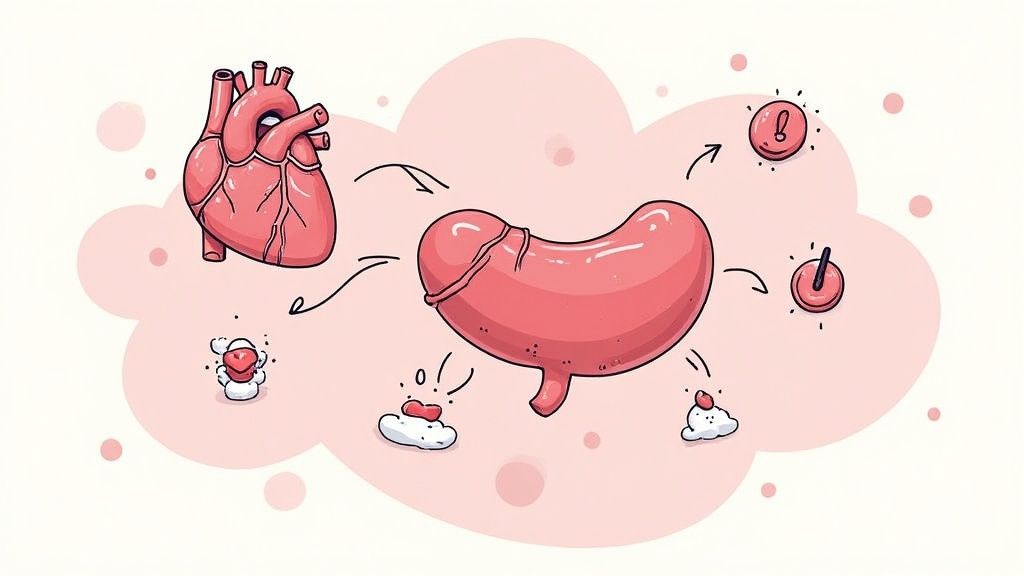
Before you can get any useful insights from a daily sugar calculator, you need to give it some solid, honest data. This means putting on your detective hat for a few days to get a clear picture of what you’re actually consuming. This isn’t about judgment; it’s about establishing a baseline so you can make smart, effective changes.
The most reliable way to do this is by keeping a simple food journal for three to five days. Seriously, don't overcomplicate it. A small notebook or the notes app on your phone is all you need. Just jot down everything that passes your lips—your morning coffee, that handful of nuts, the sauce on your chicken, everything. The more specific you can be with brands and portions, the better.
Become a Label Reader
With your food log in hand, it’s time to find the numbers. For anything that comes in a package, the nutrition label is your best friend. Your eyes should go straight to two key lines: "Total Sugars" and, more critically, the "Includes Added Sugars" line right below it. This second number is what really matters for your health.
For instance, that "healthy" looking yogurt you grab for breakfast might have 15 grams of total sugar. That sounds okay, until you see that 10 grams of it is added sugar. That’s a significant chunk of your daily limit hiding in plain sight. Understanding this difference is the key to accurate tracking.
The point here isn't just to get a final number. It’s to discover where the sugar is coming from. You'll likely be surprised by how much added sugar lurks in savory items like bread, pasta sauce, and salad dressings.
Tackling Foods Without Labels
So what happens when there’s no label? Think about your morning latte or that takeout you grabbed for lunch. This is where a little bit of smart estimation comes into play.
Most big coffee shops and restaurant chains have their nutritional information on their websites. A quick search for the specifics of your order usually gives you the exact sugar count.
For meals you make at home or get from a local spot, you’ll have to break it down. If you made spaghetti, look up the stats for the pasta, the sauce, and any other ingredients separately. If you can’t find a perfect match in an app like StopSugar, find a similar generic entry. It won’t be perfect, but a good estimate is a whole lot better than a zero. The goal is a realistic snapshot, not perfect accounting.
How to Use a Daily Sugar Intake Calculator
Alright, you've done the hard work of keeping a food diary. Now it's time for the payoff. This is where a daily sugar intake calculator really shines, turning that list of meals and snacks into numbers that actually mean something. Forget about tedious manual math—this is about getting instant clarity.
Think of a dedicated tool like the StopSugar app as your personal translator. It takes what you ate and, in just a few moments, shows you exactly where you stand with sugar.
Entering Your Foods and Portions
The heart of any good calculator is its food database. Your first step is to start plugging in the items from your food diary.
Let's say you had Greek yogurt for breakfast. When you type "Greek yogurt" into the app, you'll likely see a list of different brands and styles. This is where being specific pays off. A "plain, non-fat Greek yogurt" has a completely different sugar count than a "strawberry-flavored, full-fat" one. The closer you match your entry to what you actually ate, the more accurate your results will be.
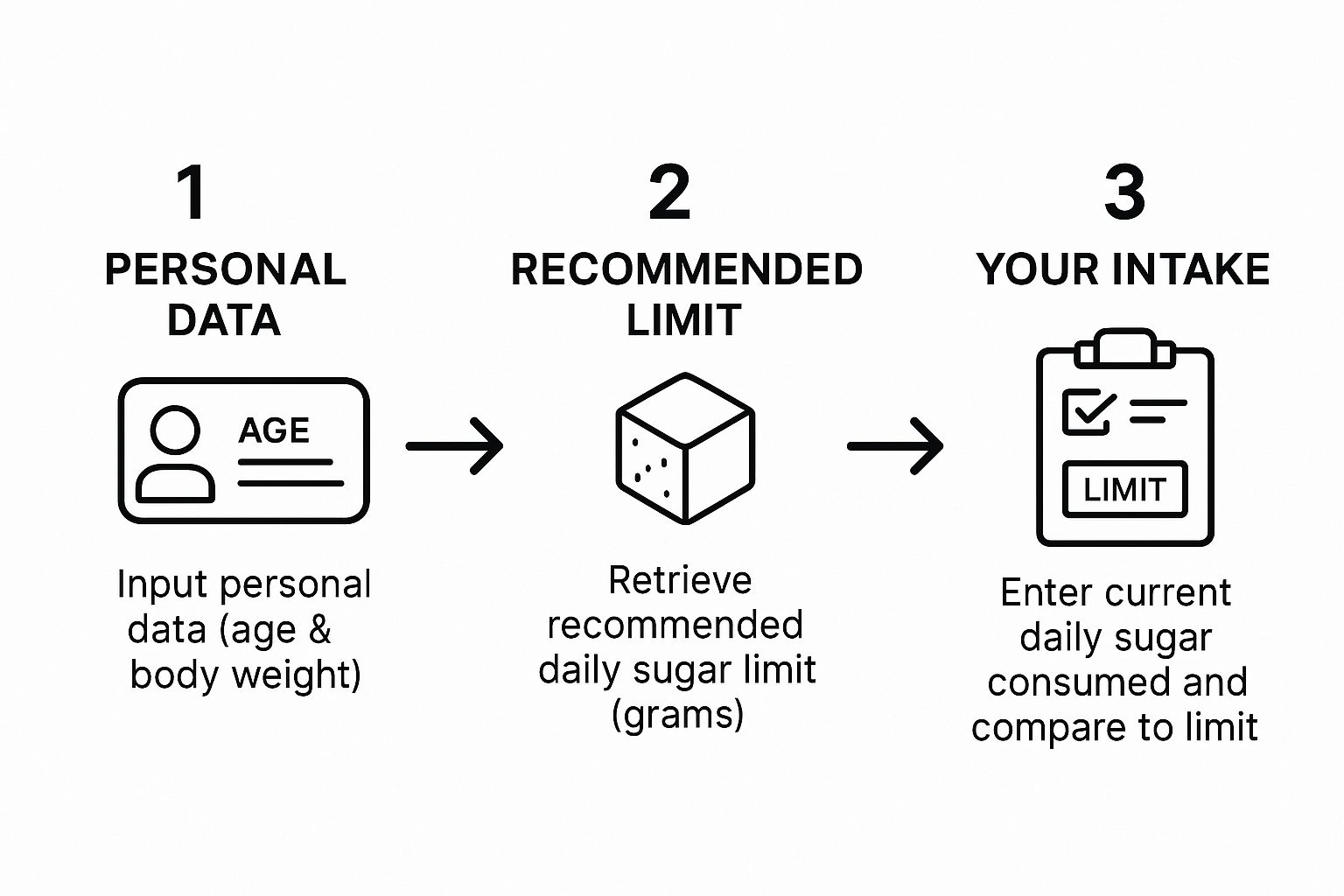
Once you've picked the right food, you just need to adjust the serving size. Did you have a full cup, or was it closer to half a cup? The calculator instantly does the math and adds the right amount of sugar to your daily total. This feature is a lifesaver, especially for foods with confusing serving sizes.
Expert Tip: A great calculator doesn't just give you a total. It separates naturally occurring sugars (like in fruit) from added sugars. This is the key. Health experts are most concerned with limiting those added sugars, which are often hiding in processed foods and drinks.
Getting Your Instant Results
One of the best parts of using an app is the immediate feedback. As you enter each food item, you'll see your daily sugar total update in real-time. There's no waiting until you’ve logged everything to see the damage.
This is where the "aha!" moments happen.
You might log your morning coffee and realize that the two sugar packets and flavored creamer just added 15 grams of sugar to your day—before you've even had breakfast. Seeing that number appear right after you enter the item is incredibly powerful. It directly connects a specific choice to a specific outcome, turning abstract health advice into a tangible, personal lesson. A good calculator makes these connections impossible to ignore.
Alright, you've diligently tracked your food, punched everything into the sugar calculator, and now you’re staring at a number. What does it actually mean?
Honestly, a number on its own is just data. The real magic happens when you connect that number to your daily habits and health goals. This is the moment where you start to see the full picture.
How Do Your Numbers Compare?
First things first, let's put your total into perspective. A great benchmark comes from the American Heart Association (AHA). They recommend that men stick to no more than 36 grams (9 teaspoons) of added sugar per day, while women should aim for 25 grams (6 teaspoons) or less.
How does your daily total look next to those figures? For many people, seeing this direct comparison for the first time is a genuine eye-opener. It’s often the nudge they need to start making changes.
Finding Your "Sugar Hotspots"
Let's walk through a real-world example to see how this works. I worked with a client, Sarah, who thought she was having a pretty healthy day. When she tracked everything, she was floored by the results.
Here’s what her day looked like:
- Morning: A vanilla latte and a fruit-on-the-bottom yogurt (35g sugar)
- Lunch: Salad topped with a fat-free raspberry vinaigrette dressing (12g sugar)
- Afternoon: One of those "healthy" granola bars (18g sugar)
- Dinner: Chicken stir-fry made with a store-bought teriyaki sauce (15g sugar)
Sarah’s grand total was a staggering 80 grams of sugar. That’s more than 3x the daily limit recommended for women. She was shocked to see that her "healthy" yogurt and granola bar were the biggest offenders, pushing her way over the limit before she even got to dinner.
This breakdown gave her a clear map of where the sugar was hiding. It wasn't in obvious treats, but in everyday foods she thought were good for her.
Think of your calculator results as your personal roadmap. They pinpoint exactly where you can make the biggest impact with the least effort—just like Sarah realized with her latte and granola bar.
This isn't just a personal struggle; it’s a global one. Total sugar consumption hit about 176 million metric tons in 2022/23. This is happening even though major health bodies, like the World Health Organization, advise keeping free sugars under 10% of our daily calories. You can dig deeper into these global dietary sugar statistics and trends if you're curious.
By identifying these hidden sugar sources, you can stop feeling overwhelmed and start feeling in control. Your results aren't a final grade—they're the key to understanding your own patterns and building a healthier relationship with food.
Ready to Cut Down on Sugar? Try These Smart Swaps Today
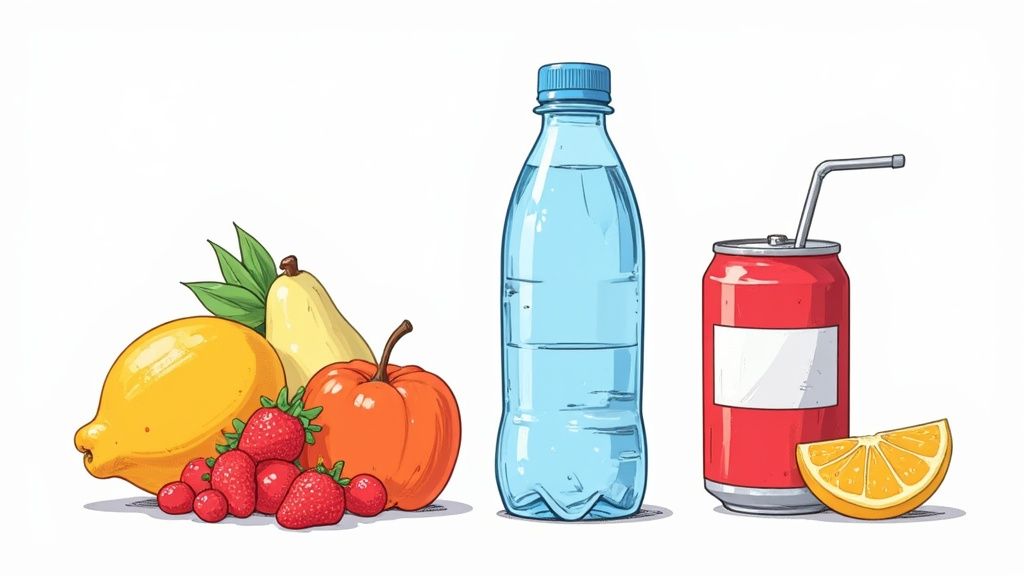
So, you've used the calculator and have your daily sugar number. Now what? The good news is you don’t have to completely flip your diet upside down overnight. Real, lasting change comes from making small, intelligent swaps that reduce sugar without making you feel like you're missing out.
It’s easy to fall into "health traps"—those foods that sound good for you but are secretly loaded with sweeteners. A great first step is simply being aware of them. For instance, just trading that afternoon soda for sparkling water with a squeeze of lime can slash nearly 40 grams of sugar from your day. That one change alone is a huge win.
Easy Wins at Every Meal
Let's get practical. Here are some simple swaps you can start making right away.
- At Breakfast: Is fruit-on-the-bottom yogurt your go-to? Try plain Greek yogurt with a handful of fresh berries instead. You still get that touch of sweetness, but from whole fruit, and you’ll save 15-20 grams of added sugar.
- For Your Lunch: Many bottled salad dressings, especially the "fat-free" kinds, are packed with sugar to make up for the lack of fat. A quick mix of olive oil, a splash of lemon juice, and a pinch of salt and pepper is a fantastic, sugar-free alternative.
- When You Need a Snack: That granola bar might seem like a healthy choice, but many are just candy bars in disguise. A small handful of almonds and a square of dark chocolate (70% cacao or higher) can hit the spot with way less sugar.
These little adjustments really do add up. Before you know it, you'll have made a serious dent in your daily total without feeling deprived.
The goal here is progress, not perfection. Making just one smart swap a day is a victory. These small changes build on each other, leading to big health benefits and even helping to reset your palate.
This approach of small, consistent changes is more important than ever. Think about this: global sugar consumption is projected to climb to an estimated 202 million metric tons by 2034. That's a staggering amount, and it makes taking control of our own habits a powerful move.
By being mindful of what you're eating and making these simple substitutions, you're not just improving your own health; you're building a defense against those bigger trends. You’ll also probably notice that as your intake drops, so do those pesky cravings. If you need a little extra help in that department, we have some great tips on how to reduce sugar cravings naturally.
We Hear These Questions All the Time
When you first start tracking what you eat, a few questions almost always pop up. Let's get those sorted out so you can feel confident and stay on track.
Do I Really Need to Count the Sugar in My Fruit?
This is a big one. For most of us, the real enemy is added sugar, not the natural stuff you find in whole foods.
Think about it: the sugar in an apple comes packaged with fiber and water. This combination is nature's way of slowing down absorption, preventing the dramatic blood sugar spikes you get from a candy bar. While our calculator tracks total sugar, your main mission should be cutting down on the added sugars lurking in processed foods, sodas, and sauces. That's what the health experts are really concerned about.
How Often Should I Be Tracking This Stuff?
You don’t need to be glued to your tracker forever. That would be exhausting! When you're just starting, give it a solid 3 to 7 days of consistent tracking. This gives you an honest, eye-opening look at where you're starting from.
After that initial week, think of it as a periodic check-in. Tracking for a day or two every few weeks is a fantastic way to make sure you haven't slipped back into old habits. It’s all about building awareness, not creating a new source of stress.
From my experience, the biggest shock for people isn't the obvious culprits like cookies or soda. It's the hidden sugar in savory foods—the pasta sauce, the bread, even the salad dressing. Always flip it over and check the label.
Understanding your habits is also key to getting a handle on those intense urges for something sweet. If you're struggling with that, our guide on how to stop sugar cravings naturally has some great, practical tips.